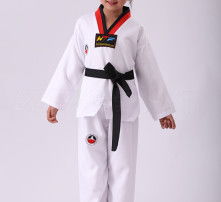跆拳道服装怎么穿
- 经验
- 2024-04-30
- 131
Title: The Artistry of Taekwondo Attire: A Visual Guide
Introduction to Taekwondo Attire:
Taekwondo, the Korean martial art renowned for its dynamic kicks and fluid movements, is not only a discipline of physical prowess but also of cultural significance. Central to the practice of Taekwondo is the attire worn by practitioners, which not only serves functional purposes but also embodies the tradition and spirit of the art. In this visual guide, we delve into the aesthetics and functionality of Taekwondo attire, exploring its key components and offering insights into its design and significance.
The Components of Taekwondo Attire:
1.
Dobok (도복):
The dobok, the traditional uniform worn by Taekwondo practitioners, consists of a jacket (jeogori) and pants (baji).
Typically white in color, the dobok symbolizes purity, humility, and the quest for perfection in Taekwondo practice.
The fabric of the dobok is lightweight and durable, allowing for ease of movement during training and competition.
The jacket features a vneck design and is secured with ties, providing flexibility and comfort to the wearer.
Embroidered patches or badges representing the practitioner's rank and affiliation may adorn the dobok, adding a personalized touch to the attire.
2.
Belt (포도):
The belt, or "tai" in Korean, signifies the practitioner's level of proficiency and experience in Taekwondo.
Belts are colorcoded to denote different ranks, with white indicating beginners and black representing advanced practitioners.

The process of earning a black belt is a journey of dedication, discipline, and mastery, with each colored belt symbolizing progress and achievement.
Visual Representation of Taekwondo Attire:
[Insert Image: Taekwondo Practitioners in Doboks]
Design Considerations and Recommendations:
1.
Comfort and Mobility:
When designing or selecting Taekwondo attire, prioritize comfort and mobility. The fabric should be breathable and stretchable, allowing for unrestricted movement during training and competition.
Avoid excessive ornamentation or embellishments that may impede movement or cause discomfort to the wearer.
2.
Durability and Quality:
Invest in doboks made from highquality fabrics that can withstand the rigors of training and frequent washing.
Reinforced stitching and seams contribute to the durability of the dobok, ensuring longevity and performance.
3.
Cultural Sensitivity:
Respect the cultural significance of Taekwondo attire by adhering to traditional designs and color schemes.
Avoid appropriating or misrepresenting elements of Korean culture in the design of Taekwondo attire.
Conclusion:
Taekwondo attire is more than just clothing; it is a symbol of tradition, discipline, and respect within the martial arts community. By understanding the components and significance of Taekwondo attire, practitioners can cultivate a deeper appreciation for the artistry and heritage of this ancient martial art. Whether in the dojo or on the competition mat, the dobok serves as a tangible expression of the values and principles that define Taekwondo.
[Insert Image: Taekwondo Attire Evolution]
References:
World Taekwondo Federation. (n.d.). Rules and Regulations. Retrieved from [link]
Kim, S. H. (2018). Taekwondo: The Essential Introduction. Blue Snake Books.
Disclaimer:
The images used in this visual guide are for illustrative purposes only and may not depict specific brands or products.
上一篇
奢侈水果名称大全
下一篇
阿玛尼手表按钮起什么作用